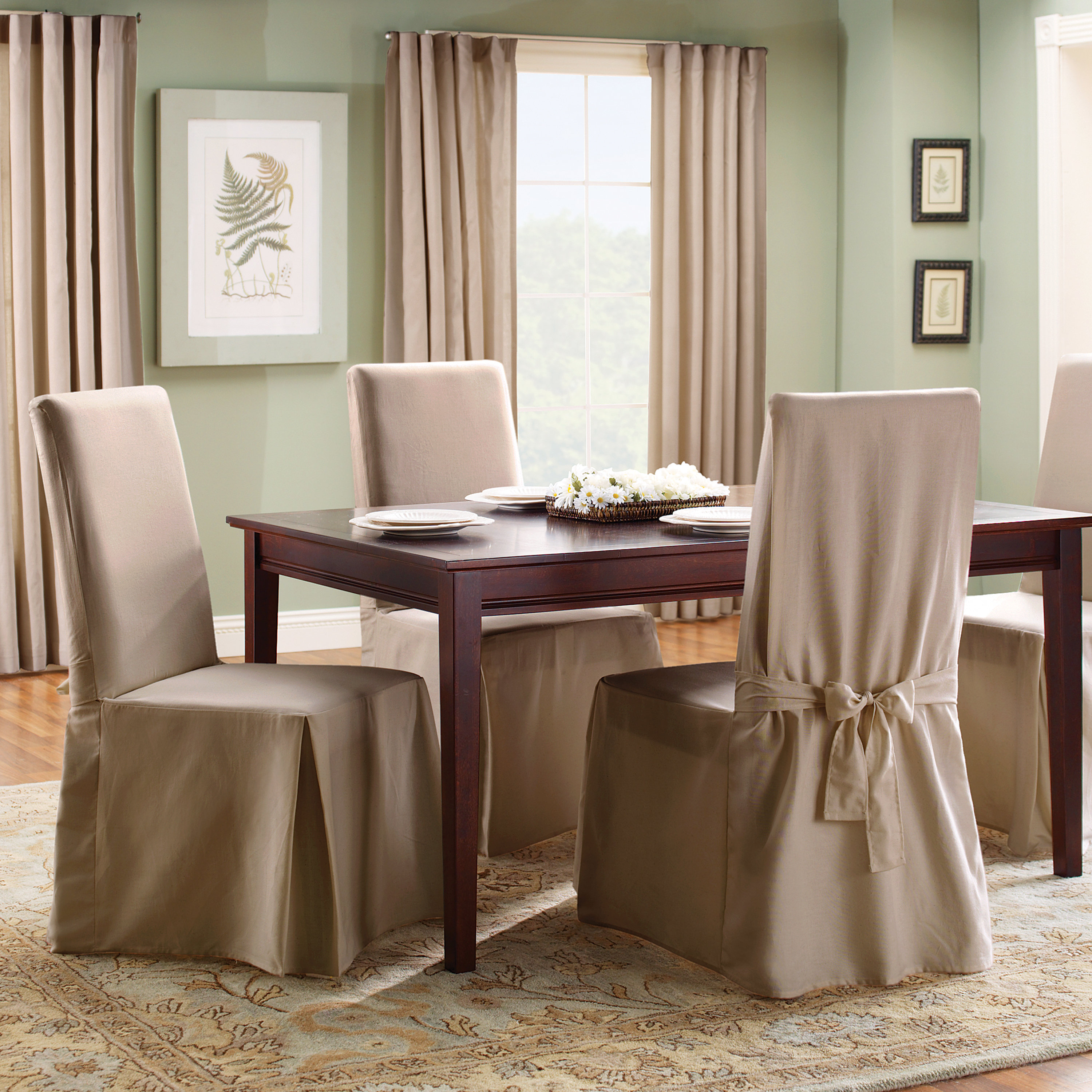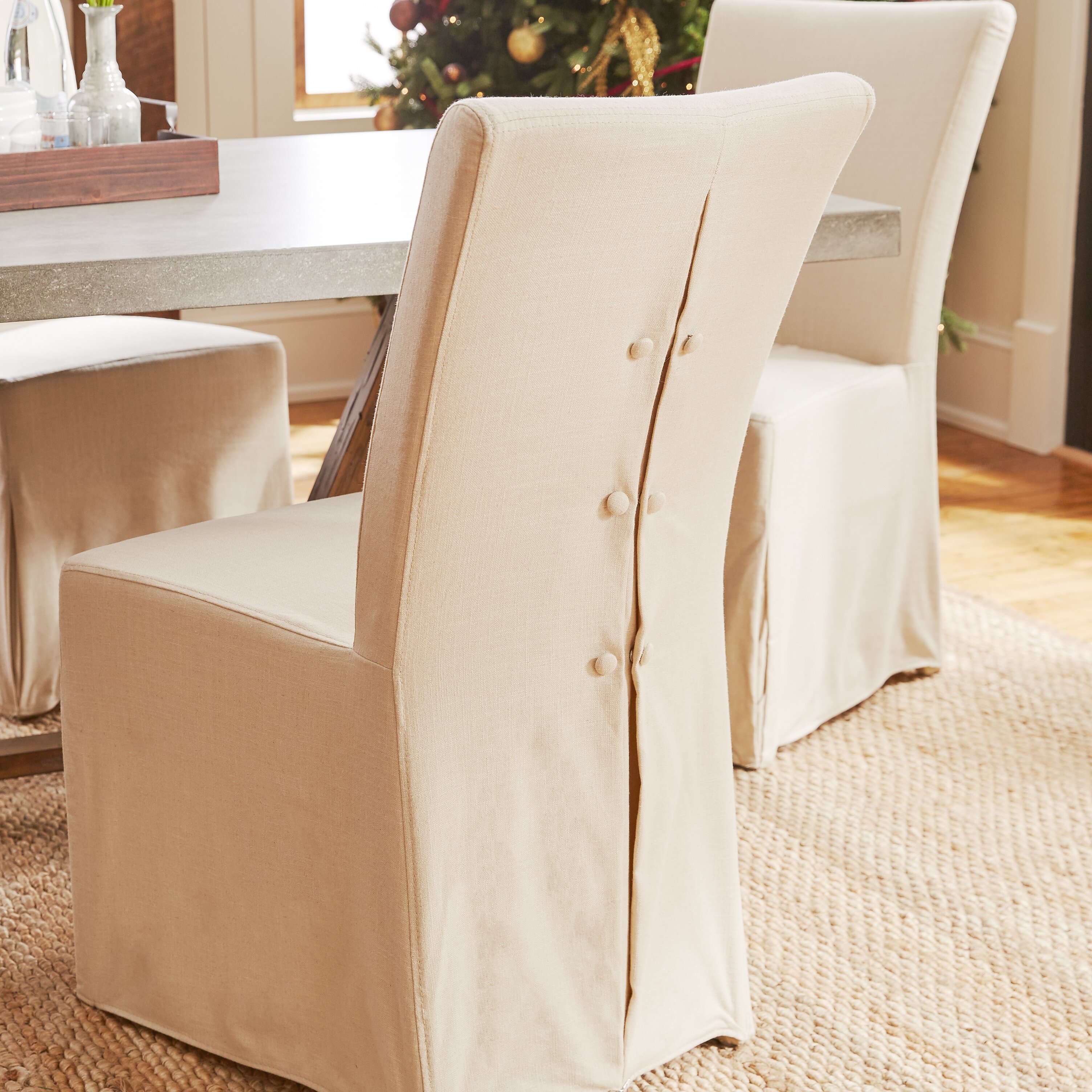Factors to Consider When Choosing Dining Chair Slipcovers in Canada

Selecting the appropriate dining chair slipcovers requires careful consideration of several key factors to ensure both functionality and aesthetic harmony within your Canadian home. The Canadian climate, with its varying temperatures and humidity levels, also influences the choice of fabric and its durability. This section will Artikel the crucial elements to evaluate before making a purchase.
Chair Dimensions and Measurements
Accurate measurements are paramount to ensuring a proper fit. Improperly sized slipcovers will appear ill-fitting and may not provide adequate protection. Purchasing slipcovers that are too small will result in a strained appearance and potential damage to the fabric; conversely, slipcovers that are too large will appear baggy and unprofessional. Before ordering, meticulously measure each chair’s dimensions.
- Step 1: Seat Width and Depth: Measure the width and depth of the chair seat. Use a measuring tape to determine the widest and deepest points, recording both measurements. [Image description: A close-up image shows a measuring tape positioned across the widest part of a dining chair seat. The tape is clearly visible, and the measurement is displayed prominently.]
- Step 2: Seat Height: Measure the height of the chair seat from the floor to the top of the seat cushion. Ensure the measuring tape is perpendicular to the floor for accuracy. [Image description: The image shows the measuring tape extending vertically from the floor to the top of the dining chair seat. The number displayed on the tape indicates the seat height.]
- Step 3: Back Height and Width: Measure the height of the chair back from the seat to the top. Also, measure the width of the chair back at its widest point. [Image description: The image displays a measuring tape that extends along the back of the dining chair from the seat to the top. Another measurement is shown across the widest part of the back.]
- Step 4: Armrest Height (if applicable): If your chairs have armrests, measure their height from the seat to the top of the armrest. [Image description: The image depicts a measuring tape positioned vertically from the chair seat to the top of the armrest, illustrating the armrest height measurement.]
Fabric Selection and Properties
The choice of fabric significantly impacts the slipcover’s durability, comfort, and ease of maintenance. Different fabrics offer varying levels of resilience to wear and tear, spills, and fading. Consider the lifestyle and needs of your household when selecting a fabric.
- Cotton: Breathable and comfortable, cotton slipcovers are relatively easy to care for. However, they can wrinkle easily and may not be as durable as other options. They are prone to shrinking after washing.
- Linen: Linen offers a luxurious look and feel, but it is more prone to wrinkling than cotton and can be more challenging to maintain. It is also more expensive.
- Polyester: Polyester is a highly durable and stain-resistant option. It is wrinkle-resistant and easy to clean, making it a practical choice for households with children or pets. However, it may not be as breathable as natural fibres.
- Velvet: Velvet provides a plush and luxurious feel, adding elegance to any dining setting. However, it is more delicate than other options and requires more careful cleaning. It can also be more expensive.
Durability, Cleanability, and Aesthetics
Beyond fabric choice, the overall durability, ease of cleaning, and aesthetic appeal are crucial considerations. A durable slipcover will withstand regular use and resist wear and tear. Easy-to-clean fabrics are essential for practicality, especially in households with children or pets. Finally, the slipcover should complement your existing décor and enhance the overall ambiance of your dining area. Consider the colour, pattern, and texture to ensure it harmonizes with your dining room’s style.
DIY vs. Pre-made Dining Chair Slipcovers: Dining Chair Slipcovers Canada

The decision to create or purchase dining chair slipcovers involves weighing several factors, primarily cost, time commitment, and desired aesthetic outcome. Pre-made slipcovers offer convenience and immediate gratification, while DIY options provide greater customization and potential cost savings. A thorough comparison illuminates the optimal choice based on individual needs and skillsets.
Pre-made versus DIY Slipcover Comparison
The following table provides a comparative analysis of pre-made and DIY dining chair slipcovers, highlighting their respective advantages and disadvantages. Careful consideration of these factors is crucial for informed decision-making.
| Feature | Pre-made | DIY | Considerations |
|---|---|---|---|
| Cost | Generally more expensive, especially for high-quality fabrics. | Potentially less expensive, depending on fabric choices and time investment. | Factor in the cost of fabric, notions, and potential alterations for DIY. Consider the hourly value of your time for the DIY option. |
| Time | Immediately available; no sewing or fitting required. | Requires significant time for pattern creation, fabric selection, cutting, sewing, and fitting. | Assess your available time and sewing proficiency. Complex designs require greater time investment. |
| Customization | Limited to available sizes and styles; fabric choices are restricted to manufacturer options. | Highly customizable; allows for precise fit and unique design choices. | Consider the complexity of your chair’s design and the level of customization required. |
| Fit | May not provide a perfect fit for all chair styles; potential for looseness or ill-fitting areas. | Allows for a precise fit, tailored to the specific dimensions of the chair. | Accurate measurements are critical for a well-fitting DIY slipcover. |
| Skill Level | No sewing skills required. | Requires basic sewing skills; advanced skills may be necessary for complex designs. | Evaluate your sewing abilities honestly. Consider starting with a simpler design if you are a beginner. |
Sewing a Simple Dining Chair Slipcover, Dining chair slipcovers canada
Creating a basic slipcover requires careful measurement, fabric selection, and basic sewing skills. The following steps Artikel the process for a standard dining chair. This guide assumes a basic understanding of sewing machine operation.
Material Requirements:
* Fabric: Measure the chair’s dimensions (height, width, depth of seat and back) and add extra for seam allowances (approximately 2 inches per seam). Choose a durable, easily washable fabric. Consider the amount of fabric needed to cover the chair completely, accounting for pattern placement and any desired pleats or gathers.
* Thread: Matching thread color for inconspicuous seams.
* Sewing Machine: A basic sewing machine with straight stitch capability.
* Pins: For securing fabric during construction.
* Scissors: Sharp fabric scissors for clean cuts.
* Measuring Tape: Accurate measurements are essential.
* Iron and Ironing Board: For pressing seams and achieving a professional finish.
Step-by-Step Process:
1. Measure and Cut: Carefully measure the chair and add seam allowances. Cut the fabric according to the measurements, creating pieces for the seat, back, and sides.
2. Assemble the Seat: Sew the seat pieces together, leaving one side open for turning. Press the seams. Turn right side out.
3. Attach the Back: Align the back piece with the seat and pin. Sew along the edges, ensuring a snug fit. Press the seams.
4. Create Side Panels: Sew the side panels together, ensuring the length corresponds to the height of the chair back. Attach the side panels to the back and seat, creating a continuous cover.
5. Hem and Finish: Finish the edges of the slipcover by hemming or using a serger to prevent fraying. Press all seams for a crisp finish.
Dining Chair Slipcover Design Styles
Three distinct slipcover styles cater to diverse interior design aesthetics.
1. Modern Minimalist Slipcover: This design features clean lines and a simple silhouette. A solid-colored linen or cotton fabric in a neutral tone (e.g., off-white, grey, or beige) creates a sleek and sophisticated look. Minimalist stitching, perhaps only along seams, ensures a clean aesthetic. The fabric should drape smoothly without excessive gathers or embellishments. The visual effect is one of understated elegance, complementing modern furniture and decor.
2. Rustic Farmhouse Slipcover: A burlap or ticking stripe fabric in muted earth tones (browns, greens, creams) creates a rustic charm. Gathers or pleats at the seat and back add texture and visual interest. Simple, functional stitching techniques are employed. The overall look is warm and inviting, with a focus on natural textures and colours that evoke a sense of comfort and simplicity.
3. Traditional Elegant Slipcover: A damask or floral print fabric in rich jewel tones (deep blues, emerald greens, burgundy) adds a touch of luxury. The fabric should have a structured drape and potentially incorporate embellishments like piping or decorative buttons. Precise stitching, perhaps with decorative topstitching, enhances the overall refined look. The visual effect is one of classic elegance, suitable for traditional dining room settings and antique furniture.
